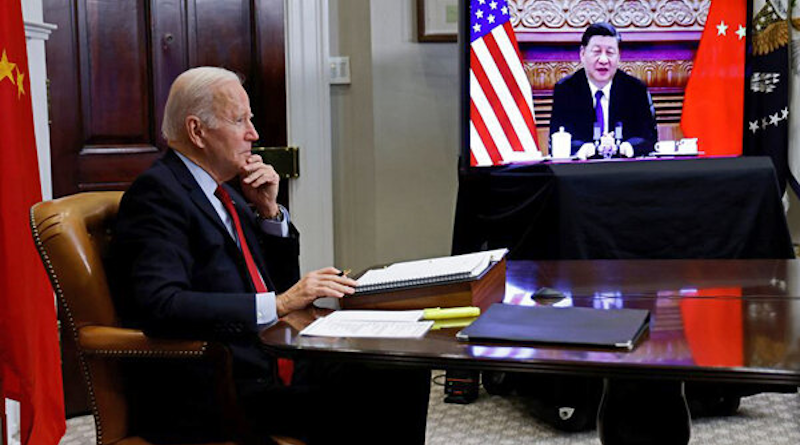
In his online meeting with China’s President Xi Jinping in November 2021, US President Joe Biden proposed guardrails for the US–China relationship. His proposal reflected deep concerns about the potential for a military confrontation due to a miscalculation or an accident.
More than a year has passed since then, so have such guardrails have been established? Is the relationship between the two countries less likely to fall off a cliff than before? The answer, unfortunately, is no. Guardrail-building has largely remained rhetorical and the US–China relationship is now closer to a historic breakdown than it has been before.
On 27 January 2022, China’s former foreign minister, Wang Yi, and US Secretary of State, Anthony Blinken, held a telephone conversation. They expressed their desire to implement an agreement their bosses had reached. That agreement called for measures to manage differences between United States and China, seek cooperation where the countries had shared interests and maintain regular dialogue and consultation.
But Washington’s diplomatic boycott of the Beijing Winter Olympics and Beijing’s statement that China–Russia cooperation has ‘no upper limits’ or ‘forbidden zones’ had already cast a shadow over relations between the two countries.
Russia’s war against Ukraine further complicated efforts to stabilise the relationship. Despite external and domestic pressure, China opted for neutrality. China did not endorse Russia’s military operations in Ukraine because they violated the UN Charter. And China did not join the West in condemning Russia because it would alienate Russia at a time when the United States is increasingly hostile toward China. Despite the fact other countries, including India, also subscribe to neutrality, the United States sees China’s position as collusion with Russia.
US congressional activism on Taiwan has made things even worse. The more than 30 draft bills and resolutionsrelated to Taiwan before the US mid-term election have had one thing in common: to shore up support for the Taiwan authorities amid rising tensions in the Taiwan Strait.
In 2016, Taiwan’s Democratic Progressive Party (DPP) took office. It challenged China’s sovereignty over Taiwan and abandoned the ‘1992 consensus’ — an agreement between the Taiwan Authorities and the Chinese Government on Taiwan’s political status in 1992. This led to Beijing increasing its political, economic and military pressure on Taiwan to deter any push for independence. Worried that Taipei might cave to Beijing’s pressure, the US Congress passed legislation and resolutions requiring the US government take stronger actions to reassure Taiwan. Confronted with a ‘tough-is-right’ consensus on China in Congress, the Biden administration chose not to challenge these bills and resolutions despite the fact that they clearly undermine China’s claims of sovereignty over Taiwan.
To many in the United States, the war in Ukraine made a Chinese military takeover of Taiwan appear more likely. Some in US Congress, including former speaker of the House of Representatives, Nancy Pelosi, chose to visit Taiwan personally. At the time of the visit, in August 2022, Pelosi was the third-highest ranking US politician. China saw Pelosi’s visit to Taiwan as a challenge to its sovereignty and territorial integrity and issued warnings to prevent the trip.
Pelosi’s visit sparked strong reactions from Beijing. China’s military undertook exercises in the Taiwan Strait. There was even speculation that China would use this opportunity to take over Taiwan. The visit also highlighted the storm brewing in the Taiwan Strait. The DPP’s goal is Taiwan independence. Because Beijing believes that Taiwan is China’s inalienable territory, it will do whatever it takes to deny Taiwan’s independence. Washington sees Taiwan as a litmus test of its alliance credibility and ideological integrity. The United States believes it has no alternative but to help defend Taiwan.
The three-way interactions in the Taiwan Strait are likely to produce two unpleasant outcomes. One is war in the Taiwan Strait. Beijing’s perceptions about Taipei’s independence-driven provocations and Washington–Taipei collusion have made it increasingly likely that Beijing may take the island by force.
The other outcome is a potential downgrade or even suspension of diplomatic relations between the United States and China. Washington has largely reneged on its commitments related to Taiwan it made in 1979, including not having formal diplomatic relations, abrogating the mutual defence treaty with Taiwan, and not stationing military personnel in Taiwan. To Beijing, these commitments were the political foundation for its diplomatic relationship with Washington. After all, the two countries could not establish diplomatic relations largely because of their disagreements over Taiwan for 20 years after the People’s Republic of China was founded.
Despite this context, the Xi–Biden meeting on 14 November 2022 in Bali did offer some hope for potential improvements in relations between China and the United States. Both leaders agreed to resume contact and dialogue on several fronts. Beijing and Washington have since followed up with some pragmatic gestures.
But fundamental differences between the two sides remain and US Congress is unwilling to change its hard-line approach toward China. As the world enters 2023, the relationship between the two world’s most consequential powers is likely to remain in choppy waters.
